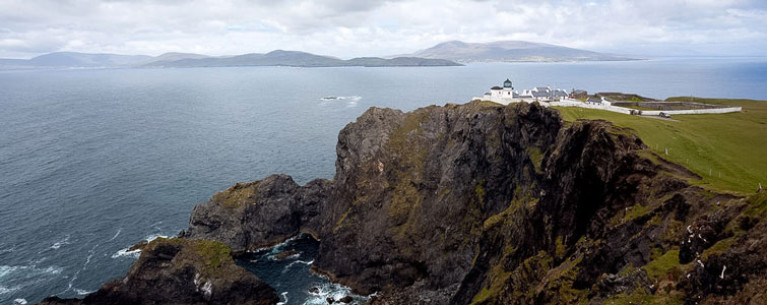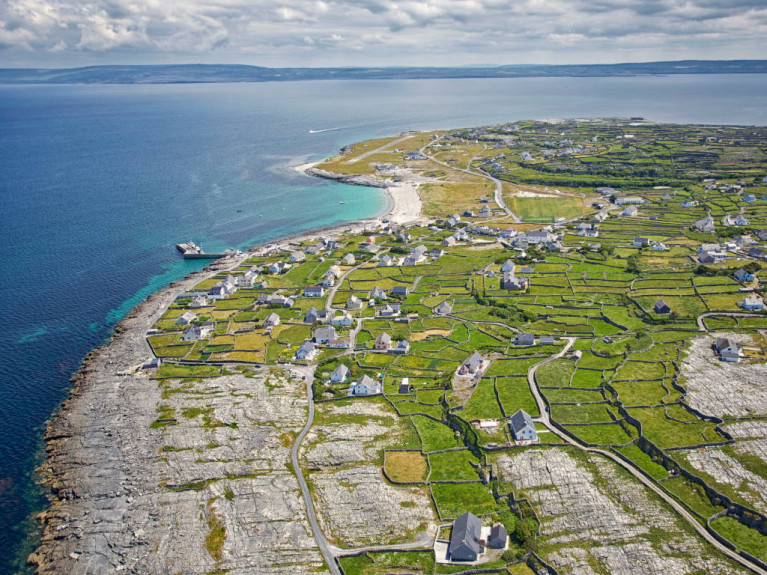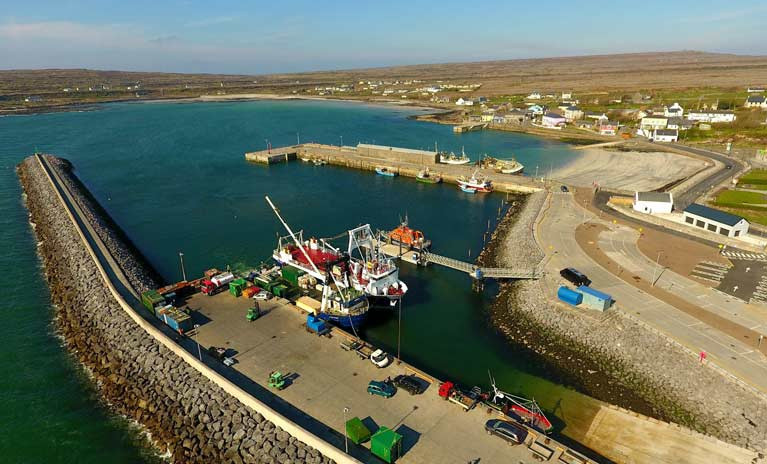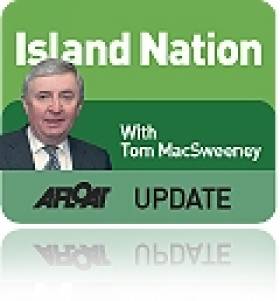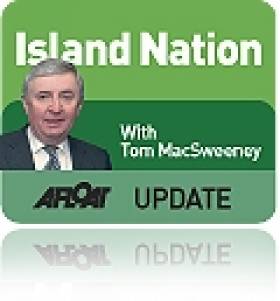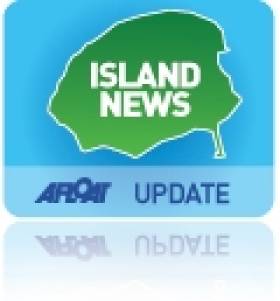Displaying items by tag: Island
The common challenges faced by island communities will be shared during the second global Virtual Island Summit which takes place in September.
Some 140 ambassadors representing some 10,000 islanders will participate in the summit online from September 7th to 13th.
The event “seeks to build digital bridges between island communities around the world, regardless of size, political status, or location,” its founder James Ellsmoor, a “Forbes 30 Under 30” entrepreneur, says.
“Islands often face similar challenges to one another but are forced to tackle them separately due to barriers created by distance, language, and culture,” he says.
"We are an island nation set on the edge of Europe, with over a dozen populated offshore islands"
National Aquarium of Ireland director of education Dr Noirín Burke, who is a team member of the Irish Ocean Literacy Network, and Inis Communications director Trish Hegarty, based in Inishowen, Co Donegal, will participate in the summit.
“We are an island nation set on the edge of Europe, with over a dozen populated offshore islands,” Ms Hegarty says.
“ This summit gives us and our offshore islanders the chance to connect with other islanders across the globe and share lessons in island innovation,” she says.
Participating ambassadors will represent island communities ranging from Ireland to Öland in Sweden, from to Fiji to Jamaica to Hawai’i and Tierra del Fuego in Chile.
For more information, visit the Island Innovation website here
Gales Cushion Impact of Island Reopening to Visitors - Sean Kyne Plays Down Impact of Social Media Post
Gales over the weekend have cushioned the impact of full re-opening of offshore islands to visitors as COVID-19-related restrictions are eased.
However, there has been a steady increase in traffic to the Aran islands, served currently by one ferry from Ros-a-Mhíl in Galway to all three islands.
Ros-a-Mhíl company Island Ferries requires passengers to wear masks. However, Comhar Caomhán Teo, the Inis Oírr co-op, has asked the Government to sanction resumption of the subsidised ferry to Inis Meáin and Inis Oírr as this would allow for greater social distancing.
Former Gaeltacht and Island minister Sean Kyne - now a senator - had argued for a phased re-opening of all islands on public health grounds, stating he had received compelling medical advice from island doctors.
He had opposed the advice from the National Public Health Emergency Team (Nphet) which had cleared visits to offshore islands from all parts of Ireland from June 29th.
Several days before the announcement, Inis Oírr said that 92 per cent of its residents and businesses oppose re-opening for the remainder of the summer due to fears over the spread of Covid-19.
There has been one confirmed case of Covid-19 to date on the largest island of Inis Mór, with a population of 800 people. All three Aran islands have had water rationing over the last couple of months, with night-time restrictions on two islands only eased last week.
Two Co Clare-based ferry companies offering seasonal day trips to the Aran islands and Cliffs of Moher did not sail to the two smaller islands last week due to the residents’ concerns.
Mr Bill O’Brien of Doolin Ferry Company, which has three vessels with capacity for almost 600 passengers in total, said he had received an email from the Inis Oírr co-op after its vote, asking his company to respect the wishes of the islanders.
“We said we’d do that, but we are hoping in a week or two that this might change,” Mr O’Brien said.
Doolin 2 Aran Ferries marketing manager Joan Hamilton said that it was also “respecting the wishes of the people of Inis Oírr” and had decided not to sail to Inis Meáin also as it had limited facilities and “it would not be fair to them”.
Inis Meáin businessman and owner of the internationally successful knitwear company Tarlach de Blacam said he believed the debate over the pressures of tourism on the islands was “now taking place”.
“People including my son [Ruairí de Blacam of the Inis Meáin Restaurant] have invested in quality accommodation on the three islands and that brings in more revenue than day-trippers,” he said. “This debate about sustainable tourism is taking place now all over Europe.”
Inis Mór wedding celebrant Dara Molloy said that effectively there had been a phased re-opening last week, as only one Island Ferries boat was sailing from Ros-a-Mhíl for all three islands and there had been “no big crowds”.
Meanwhile, as The Sunday Times reports today, Aran island residents have expressed anger and disappointment over a social media post – uploaded during a divisive debate over re-opening to visitors without adequate supports - which depicted them as one of the earliest primates in the human evolutionary tree.
The graphic, which has since been removed, compared “the people of Aran” to Australopithecus robustus, an extinct species dating to between 1.5 million and 2 million years old and first identified from fossil remains in South Africa.
Over a caption reading “Minister Sean Kyne says ‘Islanders are nervous about reopening after not seeing any tourists for a long number of months’,” the graphic showed five evolving primates with one arrow for “The people of Aran” pointing to the hunched Australopithecus and another for “People on the Mainland” pointing to upright Homo sapiens.
In the second graphic, a cartoon image of Mr Kyne depicted him as “Minister for Primitive People”.
Mr Kyne said he had been sent the links but had taken no action as he believed the debate had been very heated and such criticism was “part of the cut and thrust of politics”.
Comdháil Oileáin na hÉireann/Irish Island Network secretary Rhoda Twombly said she understood the social media graphics posted by Inis Mór’s Óstan Arann owner Keith Madigan had been removed after criticism.
She said she would “deplore anything that denigrates any of the island population”.
Mr Madigan did not respond to requests for comment.
Read more on The Sunday Times report here
Island Federation Calls on Government & Health Officials to Explain Safe Re-opening After Covid
The Irish Islands Federation has called on the Government to provide “clear guidance and protocols” on the safe re-opening of islands to visitors.
The federation, Comhdháil Oileáin na hÉireann, has also called on the National Public Health Emergency Team (NPHET) to provide more detail, amid considerable concern about its decision to approve early re-opening from next Monday, as Afloat reported earlier.
In a statement today, the island federation said it had not received any written reply to submissions to State agencies, "seeking direction and supports for the offshore islands".
“The board of Comhdháil Oileáin na hÉireann, on behalf of all offshore islands is again urgently seeking clarity and guidance from the Government regarding the safe reopening and required supports,” it said.
The NPHET decision to allow travel to and from islands to resume from June 29th, announced last Friday, threw offshore communities into confusion over the weekend.
Acting Gaeltacht minister Sean Kyne says he opposes the move and believes there should be a phased approach. He says this will be considered at this Thursday’s Cabinet meeting.
The Aran Islands, which had one confirmed case of Covid-19, has been on rationed water, and this is adding to residents’ worries if visitors are permitted.
There are also medical concerns about the elderly population’s exposure to the pandemic.
Mr Kyne said that apart from the water issue, local authorities had no time to prepare piers and public facilities and signage for an opening on June 29th.
While there has been a welcome from tourism interests, medical professionals have advised against an early opening, he said.
A survey conducted by the co-op on the Aran island of Inis Óirr last week indicated that 92 per cent of residents and businesses oppose re-opening for the remainder of the summer due to fears over the spread of Covid-19.
Islands had originally been closed until the beginning of phase five of the Government’s Covid-19 road map and expected to open again to visitors from August 10th.
Mr Kyne said that when phase five was scrapped, he received a large number of communications from island residents and businesses, expressing opposing views about the timing of re-opening.
“I’ve sent recommendations to the Taoiseach, who has been engaging with NPHET on this issue,” Mr Kyne said.
“Unless the islands can come up with an agreed position, however, the NPHET decision is the default one,” he said.
At a special sitting of the Dail Covid-19 committee late last week, Galway West TD Eamon Ó Cuiv (FF) proposed a special package of assistance to island businesses if there is later re-opening.
Gaeltacht Minister Sean Kyne says he opposes the National Public Health Emergency Team’s (NPHET) decision on an early lifting of travel restrictions to and from offshore islands.
The decision to allow travel to and from offshore islands to resume from June 29th, announced on Friday night, has thrown island communities into confusion.
There has been one case of Covid-19 on the Aran Islands, but the three islands are on water rations due to the long dry spell. There are also concerns about its elderly population’s exposure to the pandemic.
Mr Kyne said that apart from the water issue, local authorities had no time to prepare piers and public facilities and signage for an opening on June 29th.
While there has been a welcome from tourism interests, there are serious concerns among medical professionals and residents on a number of islands, he said.
A survey conducted by the co-op on the Aran island of Inis Óirr last week indicated that 92 per cent of residents and businesses oppose re-opening for the remainder of the summer due to fears over the spread of Covid-19.
Comdháil Oileáin na hÉireann is due to hold a board meeting this morning about the issue in a bid to secure a consensus in advance of next Thursday’s Cabinet meeting.
Islands had been closed until the beginning of phase five of the Government’s Covid-19 road map and expected to open again to visitors from August 10th.
Mr Kyne said that when phase five was scrapped, he received a large number of communications from island residents and businesses with opposing views about the timing of re-opening.
“I’ve sent recommendations to the Taoiseach, who has been engaging with the National Public Health Emergency Team on this issue,” Mr Kyne said.
“Unless the islands can come up with an agreed position, however, the NPHET decision is the default one,” he said.
At a special sitting of the Dail Covid-19 committee late last week, Galway West TD Eamon Ó Cuiv (FF) proposed a special package of assistance to island businesses if there is later re-opening.
The Aran islanders may have a ban on visitors, but they are already critically short of drinking water.
Irish Water and Galway County Council have introduced restrictions on water use lasting 17 hours a day on both the largest island of Inis Mór and the southernmost island, Inis Oírr.
Prolonged dry weather resulted in the first set of restrictions on April 20th, when supplies on the two islands were curtailed from 9.30 pm to 8 am daily.
The extension from 5 pm to 10 am daily is necessary to “ensure continuous daily water supply is available for residents and businesses on both islands for hygiene and other essential purposes during this continued dry spell”, Irish Water spokesman Tim O’Connor said.
Inis Oírr has suffered from long-running shortage issues, with supplementary water having to be shipped out in recent years. The three islands have had a dramatic fall-off in demand for water, since voting to shut down all tourism, including summer Irish colleges, in mid-March.
“Had we the normal level of visitors, we would be in a very serious situation now,” one Inis Mór resident noted.
“We are asking customers on both islands to be mindful of how they use water and thank them for their continuous conservation efforts to date. We would
Irish Water said it was “working at this time, with our local authority partners, contractors and others to safeguard the health and well-being of staff and the public and to ensure the continuity of drinking water and wastewater services”.
Dealing Fairly With Islanders, A Part of Our Maritime Tradition
I have a great respect for those who live on our offshore islands…They are a huge part of our national culture, history and maritime tradition. To maintain island life they deserve support from all those who interact with them, both State and private. Once again, however, the Aran Islanders who live on Inish Mór are, effectively, being held to ransom in a battle between the State, the local authority in Galway and the ferry company which serves the island. Like my phraseology or not, that is the realistic assessment of the situation and I always approach such an analysis from the basis of not alone being balanced, but being fair.
The situation is highlighted in this new edition of THIS ISLAND NATION programme, by Rhoda Twombly, Secretary of Comhdháil Óileán na hÉireann, the Islands Federation.
She is, of course, addressing the situation from the point of view of the islanders when she says: “Inish Mór is facing into another Winter of uncertain ferry service. Island Ferries has stated that they will withdraw their service to the island from the 21st of November until the following 17th of March unless there is agreement between the company, the Government and Galway County Council (GCC) on levy charges at Cill Rónáin harbour. The uncertainty of ferry service has hovered over Inish Mór for the past four years and it really is time to bring a definite resolution to the matter.”
There are, I have learned in my journalistic career, not just two sides to every story, but several, depending upon the number of sides involved, but this dispute over levies in regard to improvements to the harbour at Kilronan and the paying of them as a contribution for better facilities or, on the other hand, the commitment which the State and also, perhaps, through its local authority, should make towards the physical resources of an offshore island, has been going on for far too long. It seems to have become a “hardy annual.”
I have a great respect for those who live on our offshore islands.
I hope the ferry problem to Inish Mór will be resolved.
• Listen to Listen to Rhoda Twombly on THIS ISLAND NATION Podcast below
A Question Asked in a Kerry Boatyard
#islandnation – "Now, why would you say that Tom?"
And when Fionán Murphy rightly challenged me about my question, I did ask myself why I had just said:
"It's unusual, isn't it, for a boat for Norway to be built in Kerry?"
"I don't know why you would say Kerry, Tom," Fionán said back to me. "Ireland maybe, but why would you say 'Kerry'? The guy involved found us, came over to us and we have a fantastic relationship with him. He has been here for two months and he will be here with us until the boat is finished. It is a great place to do business because the Norwegian currency is very strong. To do anything in Norway costs a fortune, so they are getting great value for money here and we are still getting a good price for our product. It is a great place to do business and if we can do more business there, it will be fantastic."
It was a bright exchange which I enjoyed, because it is good for an interviewer to be challenged. I was trained in radio broadcasting in the days when the interviewee was the most important person, not the interviewer. Too much of radio now centres on the personality of the programme presenter, not the interviewee. I still believe that the interviewee is the most important part of an interview, so Fionán and myself chuckled at my gaffe and as Managing Director and the man who owns Murphy Marine Services on the Shore Road in Valentia Island and so an islander, he made a strong point about Kerry and the importance of our offshore islands. I was talking with him and other members of the island community who were making the point that the Government does not show enough commitment to Ireland's offshore islands. I interviewed Fionán about the future of the island and how his boatyard, which builds, maintains and stores boats, is going.
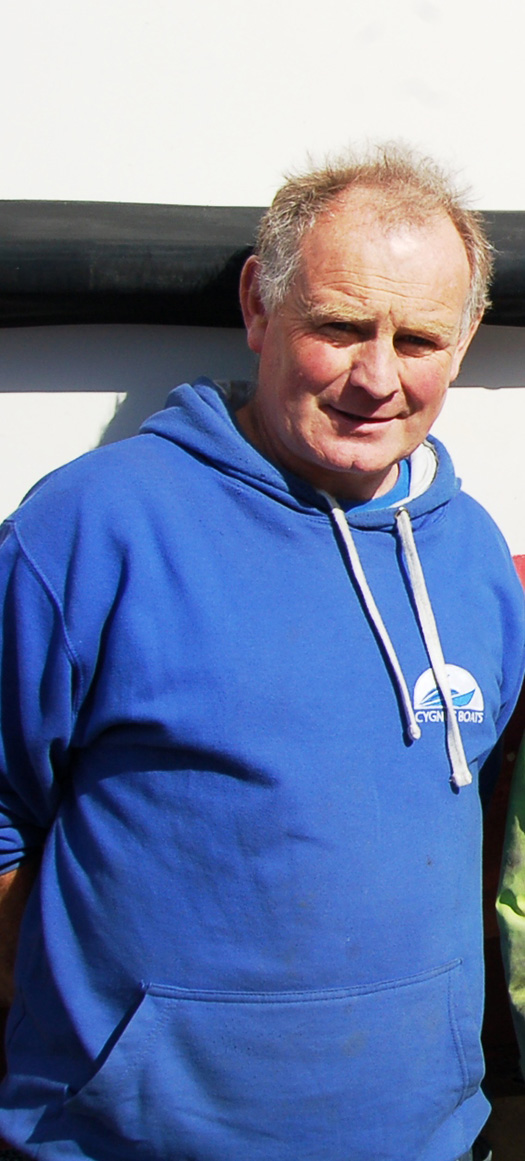
Fionán Murphy of Murphy Marine Services, Valentia Island
"Our predominant thing is new builds. If we get four-to-five of those a year we would be very happy. This keeps jobs on the island and that is what we need."
Fionán is also Chairman of the island's Development Company:
"Rural Ireland is in decline and we are doing what we can, but the island needs people and people need jobs to stay here. Islands need special recognition from the Government."
Fionán tells me in the interview, which you can hear here, how he started the yard fourteen years ago and how it has developed to its present stage of building boats which are sold all over Europe and how he overcame the economic, recessionary downturn.
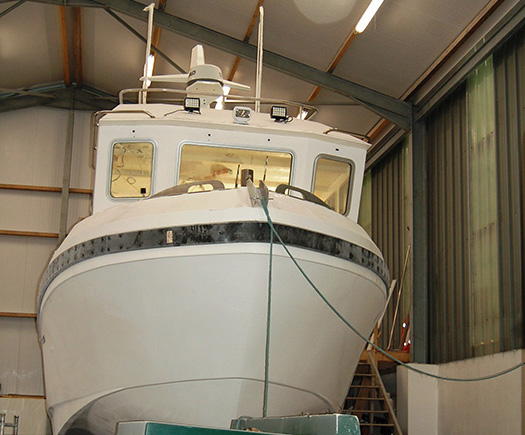
A new fishing vessel built in Valentia and bound for Norway
You can hear him on this current edition of THIS ISLAND NATION, Ireland's niche maritime programme, now broadcast on seven radio stations around the country and on this website. Also on the programme, the value of maritime safety training is emphasised by the interim Chief Executive of Bord Iascaigh Mhara, Michael Keatinge, who outlines how three fishermen's lives were saved when their boat capsized off the East Coast, because they had done the BIM safety course.
There's a lot more to be heard on THIS ISLAND NATION and you can Email me direct about the programme to: [email protected] or leave a comment below.
TV Premiere of ‘Islanders’ Airs Wednesday at 9pm on TV3
#islanderstv3 – Islanders is an emotional TV series following the lives of native islanders across an entire year. Filmed in 2014, this observational documentary is the biggest in-house production undertaken by 3Studios. From Arranmore, Co. Donegal via Inishturk in Co. Mayo to Whiddy in Co.Cork, this four part series captures a way-of-life rapidly disappearing.
As reported by Afloat back last month, the series is set within breath-taking landscapes, the islanders' stories are emotive, uplifting and told with honesty and frankness. Narrated by Irish actor Andrew Bennett ('Angela's Ashes', 'Garage', 'The Stag'), this is a landmark series for TV3, supported by the BAI.
Episode 1 begins 14 kilometres out from the Mayo coast, where the beautiful island of Inishturk reveals itself. With just 55 residents, it is home to Bríd Heanue (33) and her son Nathan (12). Bríd's eldest son Chris (16) lives and schools on the mainland.
With no secondary school on Inishturk Nathan will be leaving the island in September to join his brother at Rice College in Westport. It is a day Bríd dreads.
"In September, Nathan is leaving to go to school. That's a very emotional subject with me. It's going to be heart-breaking for me as he's been my little baby here at home. I'm going to find that very hard. All of our family are going to find that hard."
Nathan's leaving in September is going to affect the whole family – his mother will be losing her son, whilst the island will be losing another islander.
The series premiere also brings us down the coast to County Cork and in Bantry Bay, Whiddy island is the home place of twenty-two people. Here we meet two contrasting brothers: fisherman Danny O'Leary (51) and his brother Tim O'Leary (44), who is the islands publican, ferryman and post-man.
Last year the brothers got a rude awakening when they travelled to Inis Oirr on the Aran Islands for the first time. They were taken aback that other islanders had never heard of Whiddy. The few that had heard of Whiddy didn't think there were people living and working on it. The brothers were shocked and when they returned home they vowed to put their island and community back on the map.
Northwards, in the Donegal Gaeltacht, sits the stunning island of Arranmore. Just three kilometres from the coast, Arranmore has two car ferries, two co-operatives, a fire-service, a secondary school and even a nightclub! Outwardly it seems perfect but it has a problem, a problem emblematic of many islands – its population is in swift decline.
Dr Shirley Gallagher (early 40s) is a typical Arranmore Islander, born off the island in London whilst her island parents were working there, the family were reared on Arranmore. Shirley is well-travelled, well-educated and well able to speak her mind. Working in Sustainability & Environmental issues, Shirley returned home two years ago to apply all her learning and experience to her own home. She believes there are those on the island that don't want to see change whilst others are apathetic:
"When I saw the statistics on population decline I was truly shocked. You see the empty houses and derelict homes all around the place but it didn't really trigger. I thought I need to do something about this – and here I am."
Also a resident of Arranmore is mild-mannered fisherman Neilie Kavanagh (mid 40s). Although preparing for the busy season ahead, Neilie is heartbroken over the decline of the inshore fishing industry in Arranmore. The 'injustice' of what has happened to his fishing village is deeply felt and it is hard not to feel sympathy for him. He explains the Catch-22 of the 'harsh regulations'. If he is caught fishing illegally his licence will be revoked and his father's family boat will no longer be able to fish. He is the custodian of the boat – the St. Anthony, built by his father on Arranmore over 40 years ago. Neilie has never worked or lived off Arranmore.
With many twists and turns along the way, Islanders will follow the lives and stories of these characters over a tumultuous year, to learn what threatens their survival, to discover a different way of life, and to share in what it means to be an islander.
The series premiere of 'Islanders' airs this Wednesday at 9pm on TV3.
Island Communities Speak Out Against Government Policy
#islandnation – On this edition of THIS ISLAND NATION podcast I question Government policy towards two aspects of the marine sphere and ask how much confidence can be placed in the much-hyped plan to create Ocean Wealth writes Tom MacSweeney.
Several times the operation of Howth Harbour in County Dublin has been raised with me and on the programme I interview a young marine engineer who claims that the Department of the Marine has, for the past three years, been obstructing his attempts to start a marine engineering repair business there which could create jobs. But, the Department doesn't want such a facility in Howth, he claims. So what is the reality of the Government's promise to create more maritime jobs, if the Department responsible for the marine sphere is not in tune with that plan?
Add to all of that the situation in which nine offshore islands, which don't speak Irish, find that the Minister for the Environment has decided to cut off funding for community development offices on the islands and you might just wonder what is going on in this island nation? The money involved is €600,000 – not a lot in the context of overall Government spending and the Islands' Federation, the Chairman of which I talk to on the programme, maintains that the ending of support for the creation of jobs on the islands and the provision of other essential social and technological supports, could create depopulation on some of them, off the Cork and Western coastlines.
Such is the way aspects of the maritime sphere are being treated these days.
#dalkeyisland – Tanaiste Eamon Gilmore says Dalkey Island harbour slipway works on Dublin Bay (as previously reported by Afloat.ie) are expected to be completed by the end of May. In his latest newsletter to Dun Laoghaire constituents, the local TD says the €63,500 worth of minor safety improvements to the harbour 'will once again make this valuable local amenity accessible to local residents and tourists'.
The ferry service from Coliemore harbour to Dalkey Island was suspended three years ago as concerns were raised in relation to the embarking and disembarking of passengers at Coliemore and the slipway on the island.
The country's biggest boating centre with an estimated 1,000 pleasure craft is located nearby at Dun Laoghaire harbour making Dalkey island and Dalkey Sound, at the southern edge of Dublin Bay, a favourite summer time spot for boat owners to anchor and explore.
Gilmore's colleague Jan O'Sullivan, Minister for State at the Department of the Environment, signed the foreshore license to allow for the restoration of the island slip.
The works include raising the existing slipway to create a stepped top surface, widening of the existing channel, a new raised pier section with transitional steps, a handrail, mooring rings and an access ladder. More here.


























